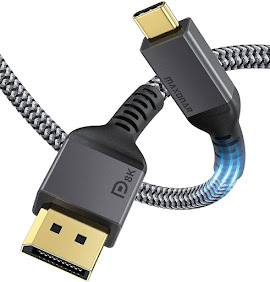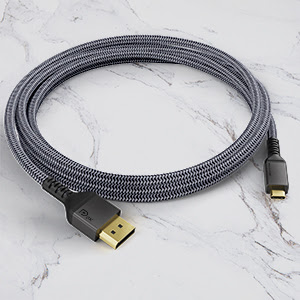Displayport is one of the newer video digital interfaces that serve as a cathode ray tube, or CRT for monitors and televisions. Displayport is one of the Video Electronics Standards Association's (VESA) newest vision in simplifying and standardizing video connections, including the common and much used VGA, DVI and HDMI interfaces.
The maximum capacity in transfer for a Displayport interface is around tens gigabits per second over a 2m cable. The Displayport connector acts as a direct competitor with the HDMI, featuring richer colors, higher resolutions and being able to hold a variety of different channels which handle device control instructions.
This particular cable has been in the markets since 2008. While the original VGA port has been extremely reliable and compliant, the Displayport cable sets a new standard which is on par with the HDMI. Possible uses for the Displayport cable range from a home entertainment system to a computer monitor. The Displayport connection allows for a direct connection from the computer onto a digital entertainment system, greatly simplifying the process and cutting out any messy wires.
Utilising a USB connection supporting 1 of 4 pairs of data including audio, video, and clock signals, the Displayport cable boasts a maximum resolution of 1080p. Although the Displayport cable itself is compliant with other HD systems such as DVI and HDMI, the Displayport connector itself is not cross compatible.
Security measures implemented into the cable includes DPCP, or otherwise known as DisplayPort Content Protection. DPCP allows for users to optionally enable content protection that can help protect transmission data from being intercepted and sent to unauthorized users from a distance. The Displayport system is also being constantly upgraded, with its development backed up by Intel is releasing new versions to the market much like the way HDMI does so.
And in comparison, when looking at Displayport and HDMI, which one is better than the other? There are a variety of answers to this, but one advantage of using Displayport is that it is currently license free, meaning that developers and computer technology manufacturers are more likely to use the Displayport connector since it is more cost effective than the HDMI which requires licensing fees. In terms of quality, the Displayport would be more or less on the same level as a HDMI, which is by far one of the best means of display HD media. Displayport has received much positive feedback from the market, and it will probably continue to do so.
The Best USB C to DisplayPort Cable - Recommendation
After doing tests on some USB-C to DisplayPort cables, I found that Maxonar DP cable have good quality materials and prices are quite affordable.
Maxonar USB-C to DisplayPort Cable:
 |
| Maxonar USB-C to DisplayPort Cable |
High-quality nylon braided jacket, The slim and lighter zinc alloy one-piece shell has better gloss and corrosion resistance. Compared with other shells, it is more rigid and reliable. 24K gold-plated interface, faster conduction, more stable signal, and will not fade.
 |
| Maxonar USB-C to DisplayPort Cable |
This cable supports the newest computers with Thunderbolt 3 (Type-c) ports; widely compatible with New M1 chip, Macbook Pro, Dell XPS, iMac, Surface Book 2, Pixelbook, Pixel Slate, Lenovo Yoga 920 and other computers and cellphone which supports DisplayPort Alternate Mode. Great for school, home or office work.
| Maxonar USB-C to DisplayPort Cable |
This is an excellent and affordable cables, currently using a Surface Book 3 and Laptop 3 (work and personal), Surface Dock 2, and 2x Dell 4K displays for productivity. These cables are high quality and feel substantial, also lined with Nylon to give them that extra premium feel. The biggest benefit of these cables is the ability to shoot 4K @ 60hz (rather than the 30hz refresh you might get with other cheaper cables) providing a much more smooth/UHD experience.
Well, that's the best USB C to DisplayPort Cable according to my research and opinion. Thank you for reading, I hope it's useful.
Related post: The Best USB C to DisplayPort Adapter

No comments:
Post a Comment